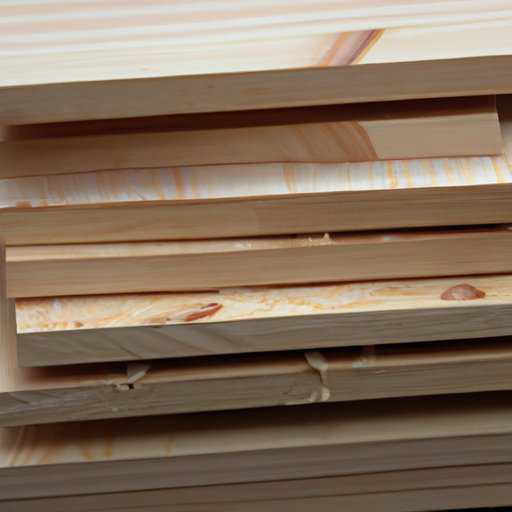
I. Introduction
When it comes to building and construction projects, using the right materials is crucial to ensure a safe and successful outcome. Plywood is a versatile wood product that is widely used in various applications, but many people may wonder: How much weight can plywood hold? This question is critical for builders, DIY enthusiasts, and furniture makers alike, and the answer depends on several factors.
In this article, we will explore the weight-bearing capacity of plywood in various scenarios and applications. We will cover the basics of plywood and its manufacturing process, how thickness and types affect weight capacity, and its load-bearing capacity in construction and furniture design. We will also delve into the impact of moisture, compare plywood with alternative materials, and provide insight into selecting the ideal kind of plywood for specific projects.
II. The Basics of Plywood and Its Weight-Bearing Capacity
Plywood is an engineered wood product made from layers of thin veneers glued together with adjacent layers arranged at right angles. The number of layers, thickness, and type of wood used to manufacture plywood vary. For example, hardwood plywood typically uses hardwood veneers, while softwood plywood uses softwood veneers, such as pine, fir, or spruce.
One critical factor that determines the weight-bearing capacity of plywood is its type. Standard plywood, for example, has lesser weight capacity than pressure-treated plywood that is specifically designed for outdoor use and is more resistant to moisture, decay, and insects.
The thickness of plywood also plays a role in its weight-bearing capacity. As a general rule, the thicker the plywood, the more weight it can support. However, there are exceptions, as some thinner plywood with a high-grade rating may have a higher weight capacity than thicker plywood with a low-grade rating.
III. Plywood’s Load-Bearing Capacity in Construction
Plywood has multiple uses in the construction industry, including as a subflooring, roof decking, and sheathing. The load-bearing capacity of plywood in construction applications depends on several factors, such as span, spacing, direction of the load, and the type of plywood used.
For example, when used as subflooring, the load-bearing capacity of plywood depends on the distance between the floor joists or the studs. The thicker the plywood, the larger the spacing between the joists can be. Similarly, when used as sheathing, plywood’s weight-bearing capacity depends on the size and spacing of the studs and the thickness of the plywood.
IV. Weight Limits for Plywood Sheathing
Sheathing is the layer of plywood that covers the exterior studs of a building and is responsible for protecting it from wind and moisture. The weight capacity of plywood sheathing depends on several factors, such as wind load, which differs based on a building’s geographical location and the orientation of the plywood panels.
Calculating weight capacity for plywood sheathing involves several variables, including sheathing thickness, stud spacing, and the expected wind loads and uplift. In general, the wind load calculation increases with the height of the building, the Exposure Category, and the building’s location.
V. Plywood’s Maximum Load Capacity for Furniture Designs
Plywood is a popular material for furniture design, thanks to its durability, cost-effectiveness, and versatility. The maximum load capacity of plywood for furniture design depends on the thickness, type, and design of the furniture piece.
The type of plywood suitable for furniture design depends on the location of the furniture and its intended use, such as indoor or outdoor use. For example, furniture pieces designed to hold weight outside, such as a garden bench or patio table, require pressure-treated plywood.
To design and construct furniture for optimum load-bearing capacity, knowledgeable tips include distributing the weight evenly, using glue and screws during assembly, and providing supportive design features.
VI. Exploring the Relationship Between Moisture and Plywood Weight Capacity
Moisture can affect the strength and weight capacity of plywood. Wood has an optimum stiffness and strength when it has a specific level of moisture content, usually around 6% to 8%. Plywood exposed to higher moisture levels than the permissible limit can result in mold, decay, or insect infestations, leading to its degradation over time.
To prevent this, it’s essential to store and use plywood in a dry location and avoid excessive moisture exposure.
VII. Comparing Plywood with Alternative Materials
Plywood is a popular choice for builders and DIY enthusiasts, but it is not the only material used to support weight in construction or furniture building. Some popular alternatives include aluminum or fiberglass in marine applications or other engineered wood products and poured concrete in construction projects.
While each material has its benefits, plywood remains an affordable, flexible, and readily available option that can handle a wide range of applications.
VIII. Ideal Choices of Plywood for Specific Projects
Choosing the right kind of plywood for a specific project can impact its weight-bearing capacity and overall success. To determine the ideal plywood for specific projects, one must consider the quality and thickness of the wood and its intended use. Some examples include:
- Interior projects: Medium density fiberboard (MDF) or A-grade plywood.
- Exterior projects: Pressure-treated plywood or marine-grade plywood.
- Furniture-building: Cabinet-grade plywood or veneer core plywood.
IX. Conclusion
Plywood’s weight-bearing capacity is critical to the success of a project, whether it’s for construction, furniture building, or other DIY projects. Understanding the relationship between plywood types, thickness, and how it is used at a project site is crucial to achieve the maximum weight-bearing capacity possible.
By selecting the right kind of plywood for specific applications and following best practices to avoid any exposure to moisture, builders, DIY enthusiasts, and furniture makers alike can achieve their desired results with confidence.
So, if you’re planning to use plywood in your next project, keep in mind the weight-bearing capacity of the chosen plywood for the specific application.





